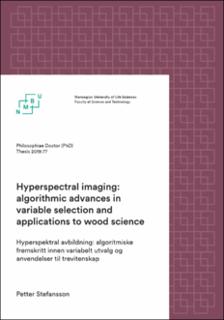| dc.contributor.advisor | Burud, Ingunn | |
| dc.contributor.advisor | Thiis, Thomas Kringlebotn | |
| dc.contributor.advisor | Liland, Kristian Hovde | |
| dc.contributor.advisor | Gobakken, Lone Ross | |
| dc.contributor.author | Stefansson, Petter | |
| dc.date.accessioned | 2022-12-19T09:34:05Z | |
| dc.date.available | 2022-12-19T09:34:05Z | |
| dc.date.issued | 2019 | |
| dc.identifier.isbn | 978-82-575-1637-6 | |
| dc.identifier.issn | 1894-6402 | |
| dc.identifier.uri | https://hdl.handle.net/11250/3038422 | |
| dc.description.abstract | According to Beer’s Law there is a linear dependence between the absorbance of a material and the concentration of an absorbing species in the material. Thus, if one is interested in modeling the concentration of an absorbing species, it should be possible to do so by utilizing a linear model to describe the concentration of the species from a measurement of the absorbance of the material. This thesis is concerned with developing such models from hyperspectral measurements taken in the visible (vis) and near infrared (NIR) region of the electromagnetic spectrum. When developing such models, it is frequently the case that a majority of the wavelengths within a measured spectrum are not absorbed by the species of interest - and should therefore preferably be excluded from the developed model in order to optimize its performance. The process of identifying unnecessary wavelengths is often driven by trial and error, as such it tends to be time consuming and computationally demanding. During the work leading up to Paper I we discovered a conceptually very simple technique which allows calculations to be recycled when developing partial least squares (PLS) models from different combinations of wavelengths. The technique can greatly reduce the computational cost of ftting multiple regression models with various combinations of included/excluded wavelengths to a dataset. In Paper II we incorporate the fndings of Paper I into a genetic algorithm (GA) and demonstrate that the technique also can be used to simultaneously evaluate— in a computationally effcient manner—combinations of wavelengths which are preprocessed using different techniques. In Paper III and IV we develop models which solve wood science related issues. In Paper III samples of spruce (Picea abies) treated with a phosphorus-based fame retardant compound were scanned using a NIR hyperspectral camera. The resulting data was subsequently used to develop a PLS model which estimated the phosphorous content from the spectral signal. In Paper IV samples of thermally modified pine (Pinus sylvestris) were repeatedly scanned over time as they dried. The resulting time series sequences of hyperspectral NIR data was used to develop a regression model capable of estimating the moisture content of the pine from the spectra. In Paper V a generic method is developed for studying and summarizing hyperspectral time series sequences in terms of known and unknown variations. The main idea of the presented method is that spectral variations of known origin are removed from the data. The remaining residual data, containing variation of unknown origin, is then subjected to dimensionality reduction in order to identify new previously unknown variations in the data; variations which in the case of hyperspectral time series data may exhibit temporal as well as spatial patterns of interest. The developed concept was experimentally evaluated in Paper V on a piece of unmodified spruce (Picea abies) which was monitored using a vis-NIR hyperspectral camera as it dried over the course of 21 hours. | en_US |
| dc.language.iso | eng | en_US |
| dc.publisher | Norwegian University of Life Sciences, Ås | en_US |
| dc.relation.ispartofseries | PhD Thesis;2019:77 | |
| dc.rights | Attribution-NonCommercial-NoDerivatives 4.0 Internasjonal | * |
| dc.rights.uri | http://creativecommons.org/licenses/by-nc-nd/4.0/deed.no | * |
| dc.subject | Hyperspectral imaging | en_US |
| dc.subject | Variable selection | en_US |
| dc.subject | Regression | en_US |
| dc.subject | Wood science | en_US |
| dc.title | Hyperspectral imaging : algorithmic advances in variable selection and applications to wood science | en_US |
| dc.title.alternative | Hyperspektral avbildning: algoritmiske fremskritt innen variabelt utvalg og anvendelser til trevitenskap | en_US |
| dc.type | Doctoral thesis | en_US |

